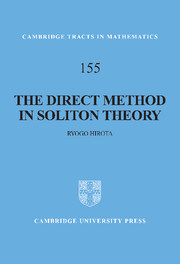2 - Determinants and pfaffians
Published online by Cambridge University Press: 13 August 2009
Summary
Introduction
In Chapter 1, we discussed transformations between soliton equations and bilinear equations and the solution of such equations. But what is a bilinear equation, or, more concretely, what mathematical structures are characteristic of bilinear equations? One answer to this question is the existence of groups (related to affine Lie algebras) which act on bilinear equations. In fact, a collective understanding of soliton equations has developed from this viewpoint, and many new soliton equations have been found using this group-theoretical method. This approach, however, calls for a deep knowledge of algebra, and, even when this has been attained, it is difficult to apply. Soon after the birth of quantum mechanics, group theory became a great craze (called Gruppenpest), where many people only studied group theory and never managed to apply it.
Since this book is aimed at students of science and technology, we omit most of the group theory.
A new viewpoint, discovered by Mikio Sato [12, 13], is to regard bilinear equations as equivalent to Plücker relations in a Grassmann manifold. This interpretation of soliton equations, based on a deep knowledge of mathematics, is admirable and beautiful, and has had a strong influence on the author. However, its later development has been so abstract that the author has not been able to understand it completely.
- Type
- Chapter
- Information
- The Direct Method in Soliton Theory , pp. 60 - 109Publisher: Cambridge University PressPrint publication year: 2004



